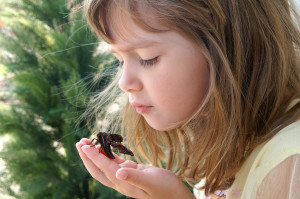 Sure, we’ve all had those days where we can’t focus, make rash decisions, and just can’t seem to sit still. But for the 3 – 5 percent of the population, both young and old, living with Attention Deficit Disorder (or ADD) these days are their norm. So where does meditation come into play in all of this? We’re glad you asked! Because meditation can be practiced in many shapes and forms, both still and busy, it can be the perfect means of self-care for those with ADD. [Read more…] about Creating Peacefulness – Meditation & Attention Deficit Disorder
Sure, we’ve all had those days where we can’t focus, make rash decisions, and just can’t seem to sit still. But for the 3 – 5 percent of the population, both young and old, living with Attention Deficit Disorder (or ADD) these days are their norm. So where does meditation come into play in all of this? We’re glad you asked! Because meditation can be practiced in many shapes and forms, both still and busy, it can be the perfect means of self-care for those with ADD. [Read more…] about Creating Peacefulness – Meditation & Attention Deficit Disorder
Compassion for Yourself
 We are bombarded with social media messages and requests from family and friends asking us to be compassionate for others. What about compassion for yourself? Being compassionate towards yourself builds patience and resilience, which in turn makes it easier to have compassion for others!
We are bombarded with social media messages and requests from family and friends asking us to be compassionate for others. What about compassion for yourself? Being compassionate towards yourself builds patience and resilience, which in turn makes it easier to have compassion for others!
First some background
Most of the Mindfulness Meditations I have talked about so far focus on paying attention to what you are experiencing right now. Sometimes I ask you to accept what you are experiencing without resistance or judgement. Some of the benefits are –
- Reducing frustration from unmet expectations.
- Reducing stress or pain by changing your perception of what is going on.
- Letting go of judgements that pops up unconsciously. A tip for recognizing some of of those judgments are that they often start with phrases like
- This means that….
- This is bad because …
- This is scary because …
Removing that judgment allows you to be more objective and opens a window for you to see yourself and others in a more compassionate light.
Compassion
The dictionary describes it as a feeling of sympathy and sorrow for another who is stricken by misfortune, accompanied by a strong desire to alleviate the suffering.
Personally I like to focus on “alleviate the suffering” because sometimes I become overwhelmed by the other person’s suffering instead of moving into action. That doesn’t help anyone!
I usually decide pretty quickly if the request is something that feels right to me and either help out or disregard the request.
My compassion tends to spring forth in situations where I see a person struggling with pain or loneliness. This explains why I did the series of articles on pain recently. For that matter my desire to help as many people as I can is what spurred me to start this website in the first place. 🙂
I will write more about fostering compassion for others another day. Today we are here to talk about YOU!
Compassion for YOU
This exercise is deceptively simple, please give it a try and practice it a few times. I find it becomes easier and more natural each time I do it.
When you first notice you are judging yourself too harshly maybe calling yourself names like stupid, or lazy or whatever your mean names you sometimes call yourself; Or if you notice you are finding fault with yourself or comparing yourself to others unfavorably do the following –
- Remind yourself that you deserve compassion.
- As you breath calmly and deeply pay attention to what you are feeling or thinking.
- Pay attention to physical sensations that come up
- Where in your body do you feel it?
- Can you identify a feeling that goes with it? For example it could be a vague uneasiness or anxiety. If you don’t easily identify a feeling that’s OK just move onto the next step.
- Acknowledge the emotion(s) that comes up. For example it may be
- I feel angry
- I feel ashamed
- I feel afraid
- I feel like crying
- Once you have identified the emotions, and where in your body you feel them it is time to start giving yourself some kindness (compassion).
- Sit in a comfortable position and breath deeply and calmly
- Take a few moments (just a minute or two to start with) and just notice what you are feeling without reacting to it or trying to change it. Just be with it for a few moments. Practicing non-resistance helps to bring objectivity and clarity … eventually. It often takes practice to get to this point.
- Acknowledge you are going to be kind to yourself
- Place your hands over your heart (which gives yourself physical reassurance and reinforces the self soothing practice that follows). Or if you have identified an area of your body that needs some kindness place your hands over that area. For example if you feel anxiety in your stomach area allow your hands to rest lightly on that area.
Speak to yourself as you would to a good friend who is in need of compassion and kindness –
- To strongly reinforce what you are saying speak out loud and use your name –
- (Your name) I understand you are feeling _____ Naming the emotion or sensation you are feeling acknowledges it without judgement.
- (Your name) It is OK to feel _____ This gives you permission to feel what you are feeling and further helps to remove judgement.
This next step is where you start moving towards kindness and compassion for yourself. Personalize this to fit what you are feeling. There are so many possible variations I will give you just a couple to give you the idea of what I mean –
For sadness you could say
- (Your name) I am here for you, I will help you. What would you like me to do for you?
- Then be still for a few moments to allow yourself to answer that question.
- Acknowledge your answer and do what you have requested if it is something that feels right and healthy.
For loneliness you could say
- (Your name) I am here for you, I love you. As you say these words allow yourself to really feel love for yourself. Repeat this as many times as you need in order to really FEEL that love.
- Address any other feelings, sensations or emotions that have come up in the same manner.
Please share any other techniques that you have found useful for fostering self compassion. It can be very useful for other readers!
To your Health!
Meditation with children
 We have covered some of the basics of meditation with children (mindfulness meditation for small children). Here are a few more points.
We have covered some of the basics of meditation with children (mindfulness meditation for small children). Here are a few more points.
Have Realistic Expectations
With small children naturally occurring mindfulness moments can happen at the most wonderful AND the most inconvenient times. You may be in a hurry to get somewhere, but if your child stops for a few moments to stare at a bug, or splash water on a rainy day, (or any of the other many distractions that fascinate your particular child) let her have a minute or two before you rush her off. After all this is a natural form of mindfulness that is often thoroughly trained out of us by the time we reach adulthood. Patience.
On the other hand if you have arranged a meditation session for your child but she simply can not sit still for even a minute, try a little game or two to see if you can get better participation. Here are a few “games” to promote mindfulness –
- Blowing bubbles, watching them float, noticing the rainbow colours in the bubbles. This is a matter of watching and seeing with very little talking for either of you 🙂
- Smelling things – a flower, grass, dirt, clothes out of the dryer, food, crayons, even water. The point is to fit in a couple of minutes of just noticing the world around whenever the opportunity presents itself.
- If your child is chatterbox and just HAS to talk about what they are doing you may as well take it in stride and not try to force silence on her.
- Play a game of noticing all the sounds that are around (birds chirping, siblings talking, clock ticking, the wind in the trees)
- Touching things and noticing the textures (soft, hard, squishy, rough, smooth)
A good idea for an older child who is fidgety is to set a timer so they can see for themselves how long they have been meditating for.
Start small, 1 or 2 minutes for a very young child and 3 – 5 minutes for an older elementary school age child. You know your own child, just how long do you think he can sit still?
Encourage Discussion
Ask your child what she noticed or felt when engaged in the meditation, at the same time don’t be too surprised if she doesn’t have many words to describe it, the areas in the brain associated with language are pretty quite during meditation.
Guidance
- Make sure your child knows there is no right or wrong way to do the meditation.
- Frequency bring results much the same as with exercise. Results come from repetition.
- Find ways to make the experience enjoyable.
- Perhaps setting aside a particular quite spot with a comfy pillow or two.
- Perhaps a reward if that is a common form of approval in your family.
- For older children try a breathing exercise with them.
- Encourage them to try their best to relax and focus on their breathing.
- Let your child know that it is normal to have thoughts pop into her head, and that when it happens to just go back to focusing on her breathing.
- When appropriate instruct your child to keep her eyes closed during meditation. Explain that keeping the eyes closed makes it easier to focus on the meditation because there are not as many distractions.
- Again, expect some fidgeting. Fidgeting is common even for adults 🙂
- Know that with practice they will be able to sit still longer with both you AND your children enjoying the benefits of meditation.
To your health!
Mindfulness meditation for small children
Teaching children meditation is unbelievably beneficial. A child who is easily frustrated can be taught to calm themselves down; a child who is very sensitive can learn to let go of hurt feelings; or a child who gets so overtired they just can’t sleep can be taught techniques to help put themselves to sleep.
Mindfulness meditation for small children
A FEW SUGGESTIONS
Be an example
Simply put, small children are natural imitators, if they see you doing meditation they are likely to want to try it out too!
Simplify the process
Make it easy to understand, especially for very young children. Use simple language and when possible use the senses – seeing, hearing, touch, smell and taste to engage them early on in mindfulness. For example – Do not have the TV turned on when they are eating, so their attention is not pulled in two directions. At the same time engage them in using their sense of taste and smell (best done when eating food they like 😉 ) by either asking questions or making comments about the food.
Use story-telling
Story-telling is a great way to tap into your child’s imagination and to help them follow along with less fidgeting. There are many great books in the market place that use story telling to teach meditation to children. From Christian or Buddhist stories to totally non religious. When looking for stories focus more on what will your child like (after all an engaged child will learn more quickly). Then focus on what fits your own moral and social beliefs and then focus on specific lessons. I picked out a couple of books and audios that are non religious, well rated and engaging. Of course I highly recommend you check out what is available for yourself, you know your child best!
Start with an easy experiment
To show what meditation is and to get your child interested in trying it show them what meditation can do. For a child over the age of about 5 for example
- Take a jar of water, add a bit of dirt or sand and shake it up.
- Explain that the dirt or sand is like our thoughts swirling around, messy and hard to see through.
- As the dirt or sand starts to settle to the bottom of the jar –
- Explain that just like the water gets clear when the junk settles down, meditation helps your head to become clear and quiet, like the water.
- Explain that when your head gets quiet so do your hurt feelings, anger or whatever the mood is that troubles your child.
- Children are smart, by explaining how meditation will help them feel better are they are more likely to give it a try 🙂
Expect fidgeting
If your child has not done any meditation before keep your expectations small, just a couple of minutes at a time and slowly build up from there. Remember 2 minutes for a child can feel like 10 minutes does for an adult!
It is natural for children to be fidgety. Keep encouraging them to come back to the meditation at hand.
Make meditation a regular practice, the more it is practiced the easier it becomes. Don’t give up if you don’t see dramatic results in the first few sessions. The best results will come with practice 🙂
Being Present – A simple walking exercise
 There are times when life feels too busy to take the time for a sit down meditation. Although a full focus meditation seems to bring best results you can still benefit from being “mindful” of what you are doing.
There are times when life feels too busy to take the time for a sit down meditation. Although a full focus meditation seems to bring best results you can still benefit from being “mindful” of what you are doing.
This exercise is about taking your mind away from thinking, planning and worrying for a few moments and instead putting your focus on where you are and what you are doing.
As in most “mindful, or being present meditations” Some of the benefits are:
- Temporarily reducing stress.
- Diverting yourself away from negative thoughts.
- Allowing yourself to focus on your other senses can help you feel more connected to the world and a little less focused on your endless stream of thoughts and worries.
- Allows you to be more aware of your surroundings.
In this case the mindfulness exercise is walking. You can fit this into your day as you walk anywhere. It could be just around your home or office or it could be the few blocks you walk to work, or school, or while you run errands.
As you walk bring your attention to the action of walking.
The idea is to be aware of yourself and your surroundings. Below are suggestions on how to do this.
Please change this (or add to it) to make it work for you. Personally, I am a visual person so I tend to focus on what I see more than the other senses, you may well find yourself paying more attention to sounds, smell or touch.
- How do your feet feel as they hit the sidewalk or floors?
- How does your body feel as you walk? As you tune into how your body feels, focus on the sensations instead of using words to describe it.
- Do you feel a breeze on your face?
- Do you feel wetness or dryness in the air?
- Breath in nice long breaths and as you breath pay attention to the smells, they may be very mild or quite strong. Breath deeply really noticing all the aromas.
- What do you see? Notice –
- Shapes
- Colours
- Textures
- Shadows
As you walk pay attention to your surroundings and the way you move through them. Allowing yourself to use all of your other senses can give you a few moments of thoughtlessness. In this case being thoughtless is good thing 🙂
As I walk I usually have a stream of thoughts that come to mind, and I have to keep bringing myself back from thinking to just seeing, hearing, smelling and feeling. At first I used to get really annoyed by how often I had to keep letting go of thoughts. After (much) practice I may still have to keep letting go of thoughts but I no longer get annoyed by it because I know that this process helps me to relax 🙂
Let me know how this exercise worked for you by making a comment below.
To your health!
Did You Know Mindful Eating Can Promote Weight Loss?
 It’s true, paying attention, I mean REALLY paying attention to your food as you eat has been shown to promote weight loss. First I will tell you how to try it yourself, then I will explain why this works.
It’s true, paying attention, I mean REALLY paying attention to your food as you eat has been shown to promote weight loss. First I will tell you how to try it yourself, then I will explain why this works.
I suggest the first time you try this when you are going to be eating something you enjoy. It will make the experience all the more enjoyable! Likewise a caution – junk food, will taste junkier! Trust me, it’s true, I’ve tried it 🙁
BEFORE YOU START
- If you are eating at work or a restaurant
- Prepare and pack a healthy meal that you know you will enjoy OR pick a restaurant that serves fresh healthy food you like.
- If you are packing your meal make sure to pack it in a way that is visually appealing.
- Get away from your desk to eat if it is hard to ignore the phone, or if you are likely to be interrupted.
- Either way make sure you find a place where you will not be pestered by anyone.
- Turn off all noise making devices (cell phone, pager etc.)
- If you are eating at home alone
- Make a healthy meal or snack that you know you will enjoy. We are talking about mindfulness as a tool to aid weight loss, so let’s keep it healthy 🙂
- Clear your table off and set it with your nicest dishes and cutlery.
- Serve your food in a manner that is visually appealing.
- Before you sit down to eat make sure you have everything you need so that you don’t have to interrupt your meal by getting up for something.
- Turn off both your home phone and your cell phone. The world can wait 15 – 20 minutes for you.
- If you are sharing a meal with someone else
- Follow the “Before You Start” instructions above and make sure to let the person you are sharing your meal with knows about your experiment so they know what to expect. Ensure it is someone who is OK with getting “the silent treatment” during the meal, preferably someone who is likely to understand and support your experiment.
ENJOY YOUR FOOD!
When you begin, remind yourself that the purpose of this experiment is to fully experience your food.
- As you uncover your food take a moment to really see how it looks. How do you feel about how it looks? Notice everything – Is the food carefully arranged or in a wonderful jumble of contrasting chaos? Are the colours really appealing? Do you like one colour more than the rest? Is there a contrast of light and dark? Heck, maybe all you notice is that looking at it makes you hungry! That’s OK 🙂
- Allow the part of your brain that thinks with words to take a brake. Instead, focus on your sense of sight, smell, touch, taste and even hearing.
- Take a good deep appreciative sniff, really smell your food. Is it strong and pungent? Is it a delicate aroma? Does the aroma make your mouth start to water? (This is a good thing, saliva starts the digestive process, aiding in effective digestion).
- Take a bite and taste the food. Is it sweet, or sour, or salty? Maybe it is spicy hot, or is it a combination of sensations?
- Notice how it feels as you bite into the food. Is it smooth and silky, or crunchy and invigorating? Is it cold or hot?
- Chew your food thoroughly , savoring the flavour(s), smell and texture.
- Listen … does the food make a noise when you bite into it?
- Can you taste the different ingredients? Is one flavour more dominant than all the rest?
- How does the food make you feel? Does it bring up any emotions or moods for you?
- Does the food satisfy your hunger?
Notice every bite, really appreciate it and pay full attention to it.
HOW DOES THIS WORK TO AID IN WEIGHT LOSS?
When eating without attention you can easily eat an extra 3 – 10 bites after you’re actually full before your body gets the message across to your distracted brain that it doesn’t want any more food. Multiply those 3 – 10 bites of food by say 3 meals and 1 or 2 snacks every day easily adds up to 15 – 50 bites of food a day that is not enjoyed, let alone physically required!
It also slows down how fast you eat so you’re less likely to overeat before your body recognizes that it has had enough food. It takes somewhere around 15 – 20 minutes for that message to get to your brain!
Some of the benefits of mindful eating are
- Recognizing when you are satisfied more quickly.
- Really enjoying your food fully.
- In a recent study had 2 groups of people were given the same food to eat. One group was told to stop eating when they were full and the other group was instructed to pay mindful attention as they ate and to stop eating when they were full. The second group consistently ate a little bit less.
- Make it a habit to really taste your food, and a lot of junk food will not seem so appealing because the very nature of junk food is to be Over salted / Too sugary / Too greasy / Artificially flavoured or Over flavoured! While it is probably better to avoid junk food all together, if you do decide to indulge take a smaller portion and really ENJOY it.

